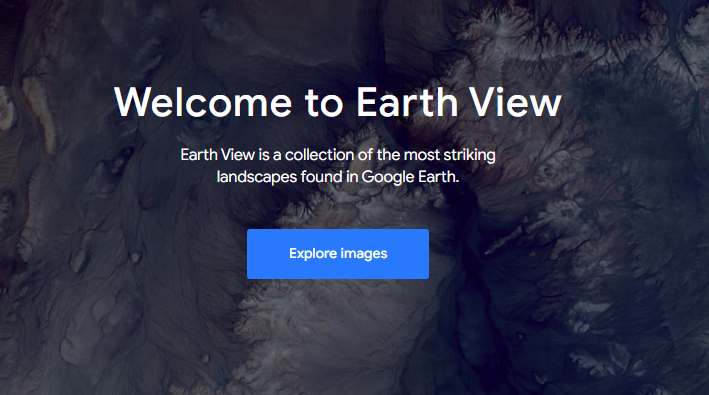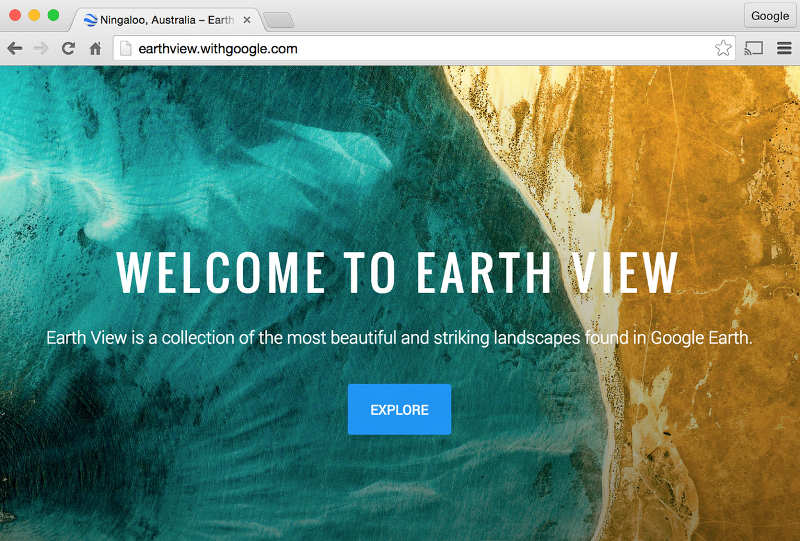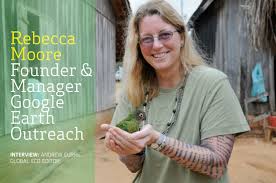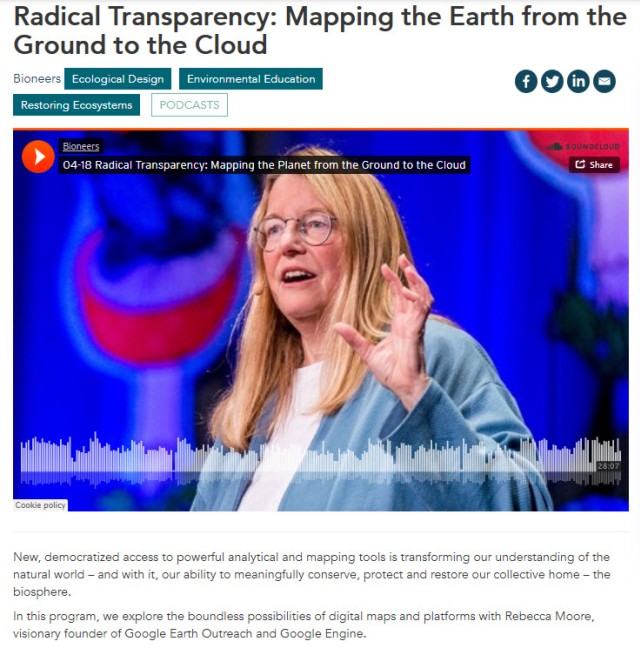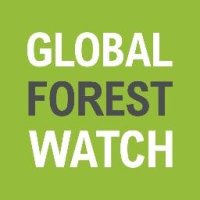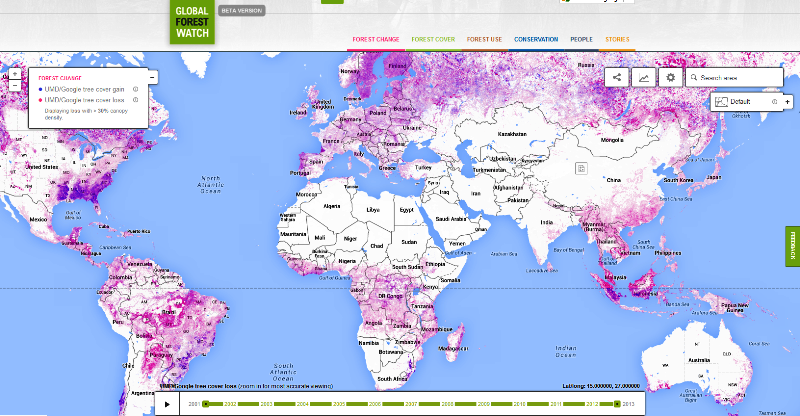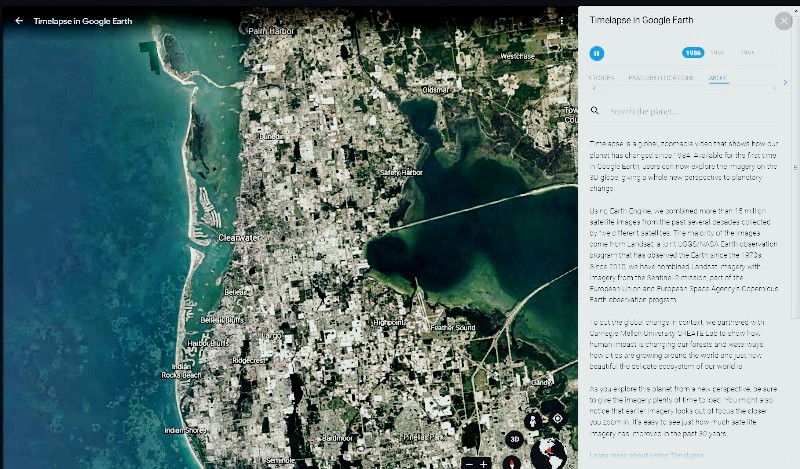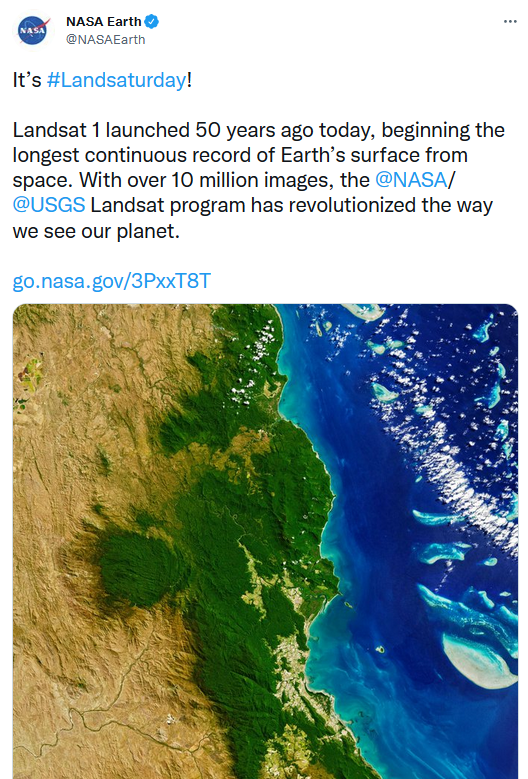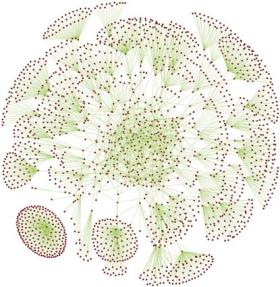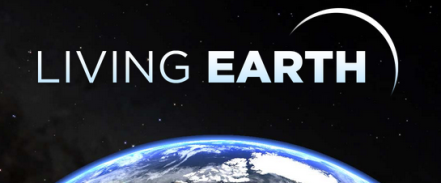Google Earth: Difference between revisions
Siterunner (talk | contribs) No edit summary |
Siterunner (talk | contribs) No edit summary |
||
| (11 intermediate revisions by the same user not shown) | |||
| Line 17: | Line 17: | ||
<big><big>'''GreenPolicy360 | <big><big>'''GreenPolicy360 looks back at 15 years of Google mapping the world'''</big></big> | ||
and 50+ Years of Landsat mapping our world after proposing/engineering/launching into orbit a revolutionary first mission with 'multispectral' digital scanning | and 50+ Years of Landsat mapping our world after proposing/engineering/launching into orbit a revolutionary first mission with 'multispectral' digital scanning | ||
| Line 55: | Line 55: | ||
''Drawn to datasets backed by real human stories, I started making my own maps with KML a few weeks after Earth’s release in 2005. For my master’s degree, I used Google Earth to build a virtual representation of a high-tech biological research reserve. Vint Cerf saw my work, which eventually led to a job on the Google Earth Outreach team, turning my passion for telling stories with maps into a career.'' | ''Drawn to datasets backed by real human stories, I started making my own maps with KML a few weeks after Earth’s release in 2005. For my master’s degree, I used Google Earth to build a virtual representation of a high-tech biological research reserve. Vint Cerf saw my work, which eventually led to a job on the Google Earth Outreach team, turning my passion for telling stories with maps into a career.'' | ||
'''Google Earth, Evolving Earth Science Tools''' | |||
''2005 was the beginning of Google Earth’s evolution, as well. In August of that year, Hurricane Katrina showed us how useful mapping tools like Earth could be for crisis response efforts. Rescue workers compared before and after Satellite imagery in Google Earth to better locate where people were stranded. And in the years after, with more than 2 billion downloads by people in nearly every country in the world, Earth has enabled people to discover new coral reefs, journey to the Moon and into deep space, find long-lost parents, clear landmines and much more.'' | ''2005 was the beginning of Google Earth’s evolution, as well. In August of that year, Hurricane Katrina showed us how useful mapping tools like Earth could be for crisis response efforts. Rescue workers compared before and after Satellite imagery in Google Earth to better locate where people were stranded. And in the years after, with more than 2 billion downloads by people in nearly every country in the world, Earth has enabled people to discover new coral reefs, journey to the Moon and into deep space, find long-lost parents, clear landmines and much more.'' | ||
| Line 60: | Line 63: | ||
''Google Earth images of Gulfport, Mississippi's shoreline before and after Hurricane Katrina'' | ''Google Earth images of Gulfport, Mississippi's shoreline before and after Hurricane Katrina'' | ||
''The ability to empower groups as diverse as school children and [http://earthobservatory.nasa.gov/Features/?eocn=topnav&eoci=features NASA scientists] to learn more about the world is what I love about Google Earth. It has the potential to make the planet a far more connected place, if you take the time to explore, discover and share what you learn. So to celebrate how far Google Earth has come and our leap into the next 10 years, | ''The ability to empower groups as diverse as school children and [http://earthobservatory.nasa.gov/Features/?eocn=topnav&eoci=features NASA scientists] to learn more about the world is what I love about Google Earth. It has the potential to make the planet a far more connected place, if you take the time to explore, discover and share what you learn. So to celebrate how far Google Earth has come and our leap into the next 10 years, we’ve created a few new ways to help you better see places from around (and above) the world.'' | ||
🌎 | |||
Now, in 2017, a Google Earth Extension | |||
<big>'''Voyager'''</big> | |||
''The world is a big place, and it can be hard to know where to begin your virtual journey.'' | ''The world is a big place, and it can be hard to know where to begin your virtual journey.'' | ||
| Line 88: | Line 96: | ||
and ... | |||
<big>'''Earth View'''</big> | |||
[[File:Welcome to Earth View from Google.png]] | |||
'''Welcome to Earth View from Google''' | |||
* https://earthview.withgoogle.com/ | |||
[[File:EarthView.png]] | |||
''Looking at our planet from above is not only a reminder of how interdependent our human and natural ecosystems are — it also lays bare the Earth’s staggering and often surreal beauty.'' | |||
''Earth View is library of some of the most striking and enigmatic landscapes available in Google Earth. It started as a 20 percent project last year by a few Googlers who enjoyed scouring satellite imagery for these gems. These images soon made their way onto Android phones, Chromecast and Chromebooks as a distinctive kind of wallpaper.'' | |||
''For Earth's 10th birthday, we're expanding the Earth View collection to 1,500 landscapes from every continent and ocean and making it accessible to even more people. The new imagery is available with an updated version of our Chrome extension and a new web gallery.'' | |||
''Download high-resolution wallpapers for your mobile and desktop devices, or better yet, print them up for your walls!'' | |||
''Thank you for the last 10 years exploring your world with Google Earth. We hope Voyager and Earth View will unlock a new perspective on our planet. We look forward to seeing what the next decade brings!'' | |||
''~ Posted by Sean Askay, Engineering Manager, Google Earth'' | |||
* https://eductechalogy.org/2017/07/04/the-new-google-earth-voyager-for-exploratory-learning/ | |||
* https://www.nytimes.com/2017/04/21/technology/google-earth-voyager.html | |||
:[[File:Blue green lines 1.png]] | |||
'''Now we shift perspective from Google executive's point of view to a GreenPolicy360 pov:''' | |||
Here is Steve Schmidt, our founder/siterunner recalling digital scanning of earth over the decades beginning with work he watched alongside Congressman George E. Brown with a first generation of digital imaging missions launched to study 'earth system science', climate change dynamics, digital technology, networking and education. The resulting first-of-their-kind digital databases were changing earth science fields at every level (Steve in the early 2000s was also a leader in digital technology, after many years of leading education technology responsible for a state K-12 public ed system and with Aspen Interactive, one of the top digital services companies in the US and world at that time.) | |||
<big>'''''Earth Views of Our Home Planet'''''</big> | |||
GreenPolicy360 / SJS-Siterunner: Google Earth brings back strong memories of Landsat, a first-ever earth imaging program that scoped and developed a platform that rolled out the beginnings of a visionary digital library. Landsat's imaging and earth observations were envisioned and designed to be used for open-access earth imaging over time and applied in myriad manners for earth science policy, environmental laws and protection, 'measuring, monitoring and managing' our living, dynamic earth systems every day and into the future by planet citizens throughout the world. | |||
[https://www.greenpolicy360.net/w/Planet_Citizen_Vision_of_Living_Earth '''Planet Citizen Vision of Living Earth]] | |||
[ | [https://www.greenpolicy360.net/w/File:You_can_manage_only_what_you_can_measure_Dr_David_Crisp,_OCO-2,_June_2014_m.jpg '''Measure to Manage'''] | ||
Take us back, GreenPolicy360, to the 1970s and the beginnings of scanning technology from space... | |||
* https://www.greenpolicy360.net/w/File:Multispectral_Scanning_Systen_-_MSS.jpg | |||
' | GreenPolicy360's founder was fortunate, beginning in the 1960s, to listen to Congressman Brown Congressman George E. Brown point to the NASA plan and explain how he saw Congress put into action the reality of a multi-year, coordinated, multi-agency program to achieve mission goals. | ||
Earth science, measuring and monitoring Earth's life-enabling systems was given highest priority. Landsat's program was set in motion as a decades long, first-ever digital scanning remote satellites data collecting study. An array of satellites began to launch, creating and combining the expanding resources of NASA, USGS, NOAA, and an array of educational and scientific institutions and aeronautics business. | |||
* https://www.greenpolicy360.net/w/George_E._Brown_Jr | |||
* https://www.greenpolicy360.net/w/File:Good_science_needs_good_data_.png | |||
* https://www.greenpolicy360.net/w/File:Above.png -- https://www.greenpolicy360.net/w/LANDSAT_and_Virginia_Tower_Norwood | |||
* https://www.greenpolicy360.net/w/File:Landsat_launched_50_years_ago_today.png -- https://www.greenpolicy360.net/w/Landsat_data_users_handbook | |||
* https://www.greenpolicy360.net/w/File:Landsat,_a_50_year_legacy.png -- https://landsat.gsfc.nasa.gov/ | |||
* https://www.greenpolicy360.net/w/Earth_Science_Research_from_Space | |||
:[[File:Blue green lines 1.png]] | |||
'''Now we shift direction again, closer to GreenPolicy360's [https://www.greenpolicy360.net/w/GreenLinks GreenLinks network], [https://www.bioneers.org Bioneers] 'r us'''' | |||
'''featuring a very special 'Bioneer' who has and is changing our world -- Rebecca Moore''' | |||
| Line 173: | Line 190: | ||
<big><big>[http://www.google.com/earth/outreach/index.html Visit Google Earth Outreach]</big></big> | <big><big>[http://www.google.com/earth/outreach/index.html Visit Google Earth Outreach]</big></big> | ||
[https://plus.google.com/104105656721944993244/posts/gEGAkFJvXvX | [https://plus.google.com/104105656721944993244/posts/gEGAkFJvXvX Read about Rebecca Moore of Google Earth Outreach] | ||
[[File:Rebecca Google Outreach.jpg]] | [[File:Rebecca Google Outreach.jpg]] | ||
| Line 334: | Line 352: | ||
[[Category:Earth]] | [[Category:Earth]] | ||
[[Category:Earth360]] | [[Category:Earth360]] | ||
[[Category:Earth Day]] | |||
[[Category:Earth Imaging]] | [[Category:Earth Imaging]] | ||
[[Category:Earth Observations]] | [[Category:Earth Observations]] | ||
| Line 350: | Line 369: | ||
[[Category:Global Security]] | [[Category:Global Security]] | ||
[[Category:Green Best Practices]] | [[Category:Green Best Practices]] | ||
[[Category:Green Politics]] | [[Category:Green Politics]] | ||
[[Category:Internet]] | [[Category:Internet]] | ||
Latest revision as of 12:39, 22 April 2023
A History of Google Earth > Google Earth Outreach
Google Earth, Introduced in 2005
- 10 Years and Multiple Version Releases Later, We have a Celebration !
🌎
GreenPolicy360 looks back at 15 years of Google mapping the world
and 50+ Years of Landsat mapping our world after proposing/engineering/launching into orbit a revolutionary first mission with 'multispectral' digital scanning
First, let's zoom in on a Google executive reminiscing about Google Earth's start up...
February 06, 2020
In memory of Elizabeth Reid
Vice President of Engineering, Google Maps
On Feb 8, 2005, Google Maps was first launched for desktop as a new solution to help people “get from point A to point B.” Today, Google Maps is used by more than 1 billion people all over the world every month.
🌎
Google Earth 2015
Via Google's Blog / Google Earth Turns 10 Today
- https://support.google.com/earth/answer/40901
- https://apps.apple.com/us/app/google-earth/id293622097
- https://earth.google.com/web/
- http://www.oldversion.com/windows/google-earth/
Posted: June 29, 2015
When Google Earth was first introduced 10 years ago, it immediately stole my heart. Beyond the freedom to fly anywhere in the world, I was captivated by the ability to paint and visualize geographic data on this incredible global canvas.
Drawn to datasets backed by real human stories, I started making my own maps with KML a few weeks after Earth’s release in 2005. For my master’s degree, I used Google Earth to build a virtual representation of a high-tech biological research reserve. Vint Cerf saw my work, which eventually led to a job on the Google Earth Outreach team, turning my passion for telling stories with maps into a career.
Google Earth, Evolving Earth Science Tools
2005 was the beginning of Google Earth’s evolution, as well. In August of that year, Hurricane Katrina showed us how useful mapping tools like Earth could be for crisis response efforts. Rescue workers compared before and after Satellite imagery in Google Earth to better locate where people were stranded. And in the years after, with more than 2 billion downloads by people in nearly every country in the world, Earth has enabled people to discover new coral reefs, journey to the Moon and into deep space, find long-lost parents, clear landmines and much more.
Google Earth images of Gulfport, Mississippi's shoreline before and after Hurricane Katrina
The ability to empower groups as diverse as school children and NASA scientists to learn more about the world is what I love about Google Earth. It has the potential to make the planet a far more connected place, if you take the time to explore, discover and share what you learn. So to celebrate how far Google Earth has come and our leap into the next 10 years, we’ve created a few new ways to help you better see places from around (and above) the world.
🌎
Now, in 2017, a Google Earth Extension
Voyager
The world is a big place, and it can be hard to know where to begin your virtual journey.
Now you can jump straight to the newest and most interesting imagery around the globe with a new layer, Voyager, available in desktop versions of Google Earth.
Different imagery types in Voyager are shown by color...
In the first edition of Voyager, you’ll find five sections to explore:
- Street View: highlights from Street View, including the Taj Mahal and the Grand Canyon
- Earth View: striking landscapes around the globe as seen from space (more below)
- '3D cities: a showcase of cities and towns available in photorealistic 3D (don’t forget to tilt!)
- Satellite imagery updates: a map of our most recently published satellite imagery
- Highlight tour: with thousands of Voyager locations to choose from, take a quick tour of a few to whet your appetite
and ...
Earth View
Welcome to Earth View from Google
Looking at our planet from above is not only a reminder of how interdependent our human and natural ecosystems are — it also lays bare the Earth’s staggering and often surreal beauty.
Earth View is library of some of the most striking and enigmatic landscapes available in Google Earth. It started as a 20 percent project last year by a few Googlers who enjoyed scouring satellite imagery for these gems. These images soon made their way onto Android phones, Chromecast and Chromebooks as a distinctive kind of wallpaper.
For Earth's 10th birthday, we're expanding the Earth View collection to 1,500 landscapes from every continent and ocean and making it accessible to even more people. The new imagery is available with an updated version of our Chrome extension and a new web gallery.
Download high-resolution wallpapers for your mobile and desktop devices, or better yet, print them up for your walls!
Thank you for the last 10 years exploring your world with Google Earth. We hope Voyager and Earth View will unlock a new perspective on our planet. We look forward to seeing what the next decade brings!
~ Posted by Sean Askay, Engineering Manager, Google Earth
Now we shift perspective from Google executive's point of view to a GreenPolicy360 pov:
Here is Steve Schmidt, our founder/siterunner recalling digital scanning of earth over the decades beginning with work he watched alongside Congressman George E. Brown with a first generation of digital imaging missions launched to study 'earth system science', climate change dynamics, digital technology, networking and education. The resulting first-of-their-kind digital databases were changing earth science fields at every level (Steve in the early 2000s was also a leader in digital technology, after many years of leading education technology responsible for a state K-12 public ed system and with Aspen Interactive, one of the top digital services companies in the US and world at that time.)
Earth Views of Our Home Planet
GreenPolicy360 / SJS-Siterunner: Google Earth brings back strong memories of Landsat, a first-ever earth imaging program that scoped and developed a platform that rolled out the beginnings of a visionary digital library. Landsat's imaging and earth observations were envisioned and designed to be used for open-access earth imaging over time and applied in myriad manners for earth science policy, environmental laws and protection, 'measuring, monitoring and managing' our living, dynamic earth systems every day and into the future by planet citizens throughout the world.
Planet Citizen Vision of Living Earth]
Take us back, GreenPolicy360, to the 1970s and the beginnings of scanning technology from space...
GreenPolicy360's founder was fortunate, beginning in the 1960s, to listen to Congressman Brown Congressman George E. Brown point to the NASA plan and explain how he saw Congress put into action the reality of a multi-year, coordinated, multi-agency program to achieve mission goals.
Earth science, measuring and monitoring Earth's life-enabling systems was given highest priority. Landsat's program was set in motion as a decades long, first-ever digital scanning remote satellites data collecting study. An array of satellites began to launch, creating and combining the expanding resources of NASA, USGS, NOAA, and an array of educational and scientific institutions and aeronautics business.
- https://www.greenpolicy360.net/w/File:Above.png -- https://www.greenpolicy360.net/w/LANDSAT_and_Virginia_Tower_Norwood
- https://www.greenpolicy360.net/w/File:Landsat_launched_50_years_ago_today.png -- https://www.greenpolicy360.net/w/Landsat_data_users_handbook
- https://www.greenpolicy360.net/w/File:Landsat,_a_50_year_legacy.png -- https://landsat.gsfc.nasa.gov/
Now we shift direction again, closer to GreenPolicy360's GreenLinks network, Bioneers 'r us'
featuring a very special 'Bioneer' who has and is changing our world -- Rebecca Moore
Read about Rebecca Moore of Google Earth Outreach
GreenPolicy360 highlights Rebecca Moore
To Planet Citizen, Rebecca Moore
- Thank you Rebecca Moore from GreenPolicy360. You're a Planet Citizen Visionary!
Rebecca envisioned setting up Google Outreach -- and she did.
- Now years later, the original idea has grown into a network of connected-cooperative Earth Outreach projects ...
A vision turned to reality... a planetary-scale platform for Earth science data & analysis, now powered by Google's cloud infrastructure
Rebecca is a long-time 'Bioneer' who continues to dream of what can be done globally and who is making a difference every day ...
As GreenPolicy siterunner Steve Schmidt wrote about her vision at the launch of Earth Outreach:
- Rebecca had an idea how to save trees around her home and her idea
- led to setting up Google Outreach - She had a great idea, she made it happen,
- she is continuing to make it happen ! Each day there's new progress, local and global...
With Google Earth Outreach as a platform for action, Rebecca has led local and global initiatives ...
Global Forest Watch & Global Fishing Watch are two most recent successful launches.
Here's a tip of our green hat to Rebecca's 'planet citizen' work
Thank You Rebecca, congratulations - time to see how it's all connected !
Planet Citizen #Earth360
http://www.greenpolicy360.net/w/Planet_API#Google_Earth_Outreach
http://www.greenpolicy360.net/w/Planet_API
○ ○ ○ ○ ○ ○ ○ ○ ○ ○ ○ ○ ○ ○
○ ○ ○ ○ ○ ○ ○ ○ ○ ○ ○ ○ ○ ○
- ○ ○ ○ ○ ○ ○ ○ ○ ○ ○ ○ ○ ○ ○ ○ ○ ○ ○ ○ ○ ○ ○ ○ ○ ○ ○ ○ ○ ○ ○ ○ ○
Clearwater !
50+ Years of Landsat, the digital imaging database is unique and a rich treasure!
Remember, we have to measure and monitor to manage intelligently
🌎
- Alternative Agriculture
- Anthropocene
- Bioneers
- Citizen Science
- Climate Change
- Climate Policy
- Earth
- Earth360
- Earth Day
- Earth Imaging
- Earth Observations
- Earth Science from Space
- Earth Science
- Earth System Science
- Eco-ethics
- Eco-nomics
- Ecology Studies
- Environmental Laws
- Environmental Protection
- EOS eco Operating System
- ESA
- Fisheries
- Forests
- Global Security
- Green Best Practices
- Green Politics
- Internet
- Maps
- NASA
- Oceans
- Ocean Ecosystem
- Ocean Science
- Ocean Sustainability
- Online Education
- Planet API
- Planet Citizen
- Planet Citizens
- Planet Citizens, Planet Scientists
- Planet Scientist
- Rights of Nature
- Strategic Demands
- Sustainability
- Sustainability Policies
- Virtual Earth
- Virtual Planet
- Whole Earth
- World Wide Web

